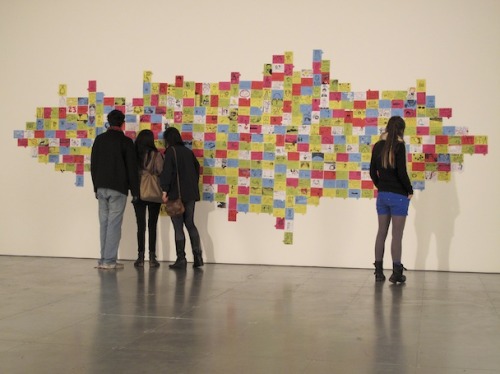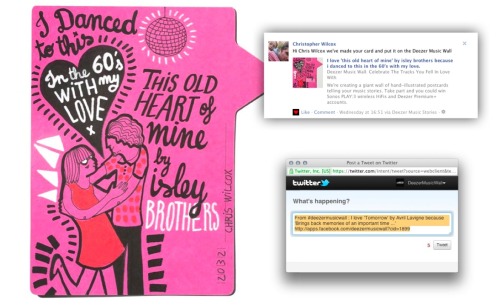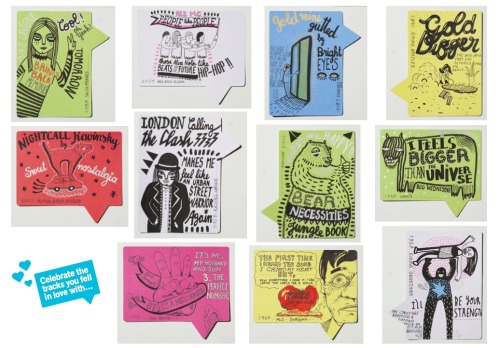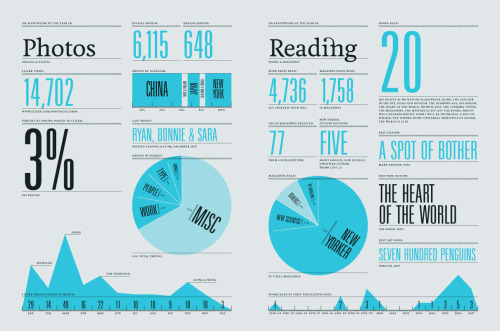Monday, September 23, 2013
I was listening to a track that
samples Mobb Deep (those great voices, words and clean accapella
skits) and I had pause to think about the effect of sampling. Not for the first
time.
This time, it was a more personal
reflection on the way that it keeps you connected to a vague notion of a
musical culture, an underground culture, no matter how that culture twists and
turns through time. Despite advancing years and the distractions and responsibilities
they bring, my attachment to underground music is seemingly pretty
much where it was at when I was a teenager. So I frequently have to ask myself
what's wrong with me. As in, 'grow up; industrial strength techno is not an
appropriate soundtrack for a man on his way to pick the kids up from school.'
But, honestly. I'm okay with it.
So, aside from a lingering concern that this might be the early gestation of a future mid-life crisis, I ponder this tendency with an entirely positive curiosity.
And, although I'm not much of a fan of the artist doing the sampling in this case (Bass producer, Mosca) it seemed to me that he and I were in a sort of dialogue. Both loving Mobb Deep irrelevant of whether that passion was sparked concurrent with the Queens hip-hop duo's reign in the mid-90s or, in the case of the much younger producer, it was a discovered legacy. That's art, right? It just doesn't really give a shit about time.
In the way he turned the sample I could hear the same reverence for their cadence, their swagger, the flow of the words and how those qualities are shot through the music that's been ground out around those samples of those voices from then to now. Time and timelessness, in order words.
But then I listened to The Martinez Brothers' H 2 Da Izzo, which takes Masters at Work's crude early garage anthem Deep Inside and twists its naive and bubbling synth melody into darker, more intense and druggy contemporary shapes. And I thought again that sampling can equally be a commentary on the passing of time and generational shifts. In this case a loss of innocence, erasing the bright eyed charm of the original in favour of a knowing appeal to the sensory experience of the contemporary club.
Finally, for about the hundredth time in the last year or so, I was locked in the raptures of Soundstream and his Dillaesque house interpretations of disco and soul edits listening to a track constructed entirely around a sample(s?) I had no knowledge of.
So here's what was happening: In a track that I've lived in I was hearing a producer turn and re-turn a moment they loved to make a track that (Dilla again) drags he listener right down to the molecular structure of that passion.
Three different thoughts about sampling, then. Each one making me reflect on sampling's incredibly complex relationship with time. One that few other musical techniques share.
And, as well, a little insight into how this music keeps playing in your head, regardless of time. And age.
Monday, December 05, 2011
The Wall of Sound

Thrills. Something I worked on with my friends at Bounce got nominated for an Econsultancy Innovation Award in the category of Innovation in Social Media. As a project that perfectly lives out my current obsession with creating the tools for the audience to create the content (ironically, this looks likely to be exploited most effectively by Spotify with the new API enabling all manner of exciting content filters to be applied for music discovery) I'm very happy to have it recognised. Credit due to Chris Wilcox whose brilliant creative technologising really nailed the creative execution.
Below is a little more detail and overview of how things worked. You be the judge as to whether we're a worthy winner.
------------------------------
The idea was to draw attention to Deezer with an activity that reinforced their critical differentiator from the music streaming competition – that this is a service by music lovers for music lovers with editorial, human recommendation and more than mere hardcore search-powered tech.
So, we developed a Facebook integrated analogue/digital (which may just be a fancy way of saying experiential/digital) experience encouraging people to share favourite songs and stories to be brought to life in real-time by illustrators working on an installation in London. Essentially, this creative concept brought the Deezer strapline promise – “Where Music Comes Alive” – to life with a perfectly physical, interactive expression of just that.
Built from hundreds of illustrated postcards, the Wall was experienced online through a gigapixel image in which you could zoom into each card and even play the relevant track.
It lives on and you play around with it right HERE.
------------------------------

1. The real-world experience
Between 19 – 24th October a group of illustrators and a gigapan-operated camera were installed in the Old Truman Brewery, off Brick Lane in East London. Through a Facebook application, audiences shared their favourite songs and the stories behind them. Illustrators turned each of these stories into unique hand-illustrated postcards and added them to the wall. The wall itself grew into both a visual and literal expression of the brand.
------------------------------

2. The digital interface
Users could view the progress of the wall through a regularly updating gigapixel image that allowed it to be browsed from afar and zoomed into in close-up. As individual cards were selected in close-up, details then loaded in allowing the associated track to be played via Deezer, the track title and user comment to be displayed, and that card to be shared through Facebook and Twitter.
------------------------------

3. Sharing
With 1000 entries we were able to send Facebook and Twitter notifications when each user entered their track. But the real excitement kicked in when a user’s card was created and added to the wall. At this point we posted to their feed both a packshot and direct link that zoomed elegantly into the gigapixel image within the Facebook app to focus on that individual’s card. These then became the focus for further conversations within Facebook. This turned 1000 entries into hundreds of thousands of impressions across Facebook.
------------------------------

Brand awareness was achieved both on the ground for a week with a living, breathing brand embodiment in high-footfall Brick Lane, through NME and Facebook advertising and, most effectively, through the sharing across Facebook and Twitter.
A new player was introduced to the busy UK music-streaming market with an exciting, engaging and truly social experience. Complex in behind-the-scenes execution, the user journey itself was beautifully simple and depended only on the demographic’s willingness to express their individuality through music. They were rewarded with a unique, creative and shareable memento which achieved the elusive but highly prized goal of all social marketing: social currency.
Wednesday, October 12, 2011
F8: Talking loud, saying something

Here's something I posted elsewhere as a first reaction to the Facebook F8 developments, no doubt it'll need a rethink as they roll out the new features and they come into focus. Meanwhile, I'm working on a project that will, in some part, use the timeline and the integration features of one of the third party partners announced at F8 at present, which I hope will be a really fun and creative exploitation, so more on that soon.
The below was originally posted on 23.9.2011:
For a Facebook sceptic, yesterday's F8 announcements were an eye-opener. There's a lot to take in but boiled to its essence, the big news is #1 the timeline and #2 integration with key third-party entertainment content brands. As with all things in Facebook's social graph stew, the two are intrinsically linked and it's these sort of tangential connections between all things in the ecosystem that makes the sum total of all yesterday's news hard to process - there's no neat beginning and end to the features.
The introduction of third party content seems like a pretty seismic development for a platform which, in the words of James Brown, often amplified the business of 'talking loud, saying nothing'. Now, integration of services like Spotify and Deezer allow realtime sharing of the music that you are listening to, the articles that you are reading - and with the integration of Netflix so far in Canada and Latin America - the TV and films you view. Crucially, this takes out that moment of consideration in the sharing process - the one where you think 'how will sharing this make me look to my friends' - instead replacing it with an unmediated stream of the audiences' actual media consumption. So, enjoy watching your most considered friends unmasked as avid Coronation Street viewers, lovers of REO Speedwagon and aficionados of the films of Kevin Bacon.
The Timeline is a much richer way of presenting the individual's story and answers the issue of what to do with The Wall, given that most people now only interact with the News Feed. We're big fans of the lovely Memolane start-up here and there's a similar richness to the Facebook timeline which was influenced by the personal infographics or 'scrapbooks' of designer Nicholas Felton (pictured).

This is a really exciting development for people like us, whose ambition is to make rich social applications that enable audiences to connect in social media and celebrate passions and interests. Apps now feel so much more central to the experience and will have to be smarter, richer and more personalised for the most sophisticated users.
Content, of course, becomes ever-more the principle currency for brands looking to interact in these spaces and the announcement of verb-based 'actions' to add crucial nuance to the act of 'Liking' content, opens up a new seam of advertising potential through Facebook's Sponsored Stories product. Integration with the social graph is crucial to driving the potential of this data and the humble Facebook brand Page - always a thin proposition - now looks woefully insufficient.
The overall impact is a significant further stride towards Zuckerberg's ambition to channel your web experience through Facebook, building a sort of shopping mall of digital content (albeit with Deezer, The Guardian, Netflix and others boasting some pretty great shops). Perhaps there are those of us who will prefer to continue making trips to boutique high street shops but, unquestionably, these are huge advances for the world's favourite social network.
Thursday, July 07, 2011
We stopped being ourselves without realising it
Back in January Laura Miller wrote an interesting piece in The Guardian about the faltering way in which the novel has slowly acknowledged the existence of the internet. The point being that literature tends to be reticent about subject matter that's likely to date the text; Miller points out that big names like Cormac McCarthy and Annie Proulx tend to stage their drama amongst the mountains and plains of ranchland America where laptops (let alone iPads) never threaten to puncture the mythical mise en scene.
It was this article that turned me on to Jennifer Egan's 'A Visit From The Goon Squad', which won this year's Pulitzer Prize for fiction. As Miller writes, this is a book that manages to address both the culture of social media and the cultural implications of this new world. The 'voice' that social media gives the individual is, she claims, presently only heard when it sings in harmony with enough others - providing enough data to tease out valuable analysis and quantifiable results - to become of note to the corporation. Or put another way - did you try getting most of your friends to communicate with you through any other platform than Facebook?
Egan's novel envisions a future in which a toddler demographic, just capable of operating simple mobile handsets is referred to by marketers as 'pointers'. For music mogul, Bennie Salazar, these mini consumers represent the 'reach' he needs to revive his ailing music empire, once founded on, you know, music. In this world, bloggers are 'parrots' and 50 such parrots are enough to create 'authentic word of mouth' for the live debut of a dismal musician. Operating this marketing infrastructure are young professionals whose "every bite of information" is "stored in the databases of multinationals who swore they would never, ever use it." As Egan puts it, this generation sold themselves "unthinkingly at the very point in [...] life when [they'd] felt most subversive."
So far, so much dystopian literary analysis of consumer culture. But can a vision like this really be considered dystopian at a time when we're learning that our media institutions consider news gathering to be the business of private detectives and hackers, when evidence in the murder of a child can be tampered with in the name of the communications industry? Perhaps it's not so far fetched.
What the book fails to acknowledge though, is the disruption and anarchy that we're seeing in digital channels right now. If you use Twitter, you can't possibly have failed to feel the impact of the News Of The World story and, certainly, News International has felt its impact as the advertisers have been (let's be honest) forced to withdraw, at least for a spell. In the brand world, other great examples abound. My favourite from recent months was that in which US fashion retailer Urban Outfitters was hung out to dry on Twitter after ripping off an independent designer's work - a practice that's long been rife in this industry but will surely now be reassessed by the major brands in the light of the damage it can do (we can do) to their reputation. Take a look at the story in full - it's a little bit heart-warming.
So, could it be that Egan's analysis is one of old world expectation applied to new world potential? Isn't there just a glimmer of hope here that, rather than turning us into drones to be co-opted into colouring the myth that propels the dismal musician to superstardom, we can in fact call out the emperor in his new clothes through these very channels. Unless we recognise the potential of the tools we have, there's a danger that we'll fail to notice as they're slowly taken away from us (Twitter users should keep a watchful eye on developments there over the coming months as they try to make good on their need to become a more effective channel for advertisers).
This isn't about some anarchic dismantling of the status quo but simply the emergence of a communications environment in which some truth and substance are returned to brand promises, where great products and businesses succeed by communicating their intrinsic values and their message is carried by their audience. Here's hoping that the novel is still just a little behind the people where digital communications are concerned, then.
It was this article that turned me on to Jennifer Egan's 'A Visit From The Goon Squad', which won this year's Pulitzer Prize for fiction. As Miller writes, this is a book that manages to address both the culture of social media and the cultural implications of this new world. The 'voice' that social media gives the individual is, she claims, presently only heard when it sings in harmony with enough others - providing enough data to tease out valuable analysis and quantifiable results - to become of note to the corporation. Or put another way - did you try getting most of your friends to communicate with you through any other platform than Facebook?
Egan's novel envisions a future in which a toddler demographic, just capable of operating simple mobile handsets is referred to by marketers as 'pointers'. For music mogul, Bennie Salazar, these mini consumers represent the 'reach' he needs to revive his ailing music empire, once founded on, you know, music. In this world, bloggers are 'parrots' and 50 such parrots are enough to create 'authentic word of mouth' for the live debut of a dismal musician. Operating this marketing infrastructure are young professionals whose "every bite of information" is "stored in the databases of multinationals who swore they would never, ever use it." As Egan puts it, this generation sold themselves "unthinkingly at the very point in [...] life when [they'd] felt most subversive."
So far, so much dystopian literary analysis of consumer culture. But can a vision like this really be considered dystopian at a time when we're learning that our media institutions consider news gathering to be the business of private detectives and hackers, when evidence in the murder of a child can be tampered with in the name of the communications industry? Perhaps it's not so far fetched.
What the book fails to acknowledge though, is the disruption and anarchy that we're seeing in digital channels right now. If you use Twitter, you can't possibly have failed to feel the impact of the News Of The World story and, certainly, News International has felt its impact as the advertisers have been (let's be honest) forced to withdraw, at least for a spell. In the brand world, other great examples abound. My favourite from recent months was that in which US fashion retailer Urban Outfitters was hung out to dry on Twitter after ripping off an independent designer's work - a practice that's long been rife in this industry but will surely now be reassessed by the major brands in the light of the damage it can do (we can do) to their reputation. Take a look at the story in full - it's a little bit heart-warming.
So, could it be that Egan's analysis is one of old world expectation applied to new world potential? Isn't there just a glimmer of hope here that, rather than turning us into drones to be co-opted into colouring the myth that propels the dismal musician to superstardom, we can in fact call out the emperor in his new clothes through these very channels. Unless we recognise the potential of the tools we have, there's a danger that we'll fail to notice as they're slowly taken away from us (Twitter users should keep a watchful eye on developments there over the coming months as they try to make good on their need to become a more effective channel for advertisers).
This isn't about some anarchic dismantling of the status quo but simply the emergence of a communications environment in which some truth and substance are returned to brand promises, where great products and businesses succeed by communicating their intrinsic values and their message is carried by their audience. Here's hoping that the novel is still just a little behind the people where digital communications are concerned, then.
Sunday, June 05, 2011
Friday, May 13, 2011
Twitter and the death of Sufjan Stevens

Last night's Sufjan Stevens show - the first of two dates at the Royal Festival Hall for the US indie deity - was remarkable for two reasons. Firstly, it may just be the best show I've ever seen at this fantastic venue. Secondly, the excitement he managed to whip up in the room led to so much Twitter activity that some users seemingly considered the possibility he'd died.
Fascinating, because it highlights both the best and worst of Twitter. It's a fantastic thing that a digital outlet allows for the mass outpouring of collective enthusiasm in that way. It gives us a forum to ask: 'It wasn't just me right? That was amazing, wasn't it?' And despite a few churlish types (notably those most active on Twitter last night) the collective record they created conveyed at least something of the wonder of the show but also hinted at its flaws and contradictions.
However, the Twitter community deals in absolutes and what struck me halfway into the show was how challenging it would be to review, to do justice to its variety and vitality, to his creative imagination and its startling contrasts in light and dark, calm and chaos, simplicity and the utterly baroque. But on Twitter of course, it was either 'amazing' or 'ridiculous', in fact the most insightful commentary I've found in a single Tweet is this, from @kofisarfo: 'It was fantastic and absurd!'
David Cheal, writing for The Arts Desk, manages to clock up both the most Twitter mentions riding the trending wave and the only comprehensive review to be published less than 12 hours after the show. Huge respect on that count, given what a challenge it is to deliver a review of a show like this to such a tight deadline.
The downside to all this activity is that this is, so far, the only professional review that's been published. So, why aren't more publications rising to the challenge of editorial that can rival the instantaneity culture of the social web and deliver satisfyingly nuanced reportage? After all the Twitter stream itself is really just one long, crowdsourced review of sorts. The answers are complex and the diminishing value of editorial in our connected culture and suspicion of the singular author both play their part, not to mention the clear superiority of Twitter's business model over that of websites like The Arts Desk.
Wonderful gig though, and a great indication of what makes Twitter so compelling. It's a passion platform; a medium for those that intrinsically have something to say. So when will online journalism rise to its challenge.
Tuesday, April 12, 2011
Instagram analogue

There's plenty being written about Instagram at the moment as we lay bets on its continuing success, but amongst it all what I've learnt from the service is how primitive our requirements of technology remain. I mean this in the best possible sense: there is something reassuringly human and simple that is key to the service's success.
Compare it with Flickr which is great in its own way (although it seems to have been stalled for a good few years now) and the parred down basics of its success become clear. Flickr offers tonnes of functionality from mapping images to slideshows, multiple scaling options, privacy settings and uploader tools. Instagram has a few simple filters and the sharing infrastructure of Twitter, with simple options to extend beyond the network into your other social destinations on an image-by-image basis. So, ease of use and real time social sharing are the key to the success of a service that unlocks our intrinsic urge to share in a manner that avoids the clanging premeditation of the worst Tweets and status updates.
What has become clearer since Instagram released its API and the fans and entrepreneurs (or likely, both combined in the best cases) have gone to work is the irresistible pull towards the analogue world that these modest social time capsules inspire. The filters may be a re-presentation of the analogue effect but there's a very tangible physical allure that has manifested great service initiatives like Instaprint - a location based photo booth that prints out Instagram images based on hashtags relevant to localised activity - and Stickygram - which promises to deliver your Instagram images as fridge magnets. There's also Instagoodies which creates sticker books from your Instagram pics, Teenytile that makes 2" ceramic tiles from your feed and all manner of other services for printing, framing and displaying pictures in realworld settings.
Somehow this flurry of 'analogue' (I know its not strictly correct) activity somehow embodies the appeal of the service perfectly. Of course, I could be missing the point and the API extension that really nails the Instagram phenomenon might just be this.
PS. Special mention to Postagram which I just came across after hitting 'Publish' - postcards of your Instagram pics, of course.





